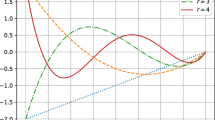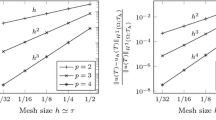Abstract
In this paper we propose and analyze a Discontinuous Galerkin method for a linear parabolic problem with dynamic boundary conditions. We present the formulation and prove stability and optimal a priori error estimates for the fully discrete scheme. More precisely, using polynomials of degree \(p\ge 1\) on meshes with granularity h along with a backward Euler time-stepping scheme with time-step \(\Delta t\), we prove that the fully-discrete solution is bounded by the data and it converges, in a suitable (mesh-dependent) energy norm, to the exact solution with optimal order \(h^p + \Delta t\). The sharpness of the theoretical estimates are verified through several numerical experiments.

Similar content being viewed by others
References
Adams, R.A., Fournier, J.J.F.: Sobolev Spaces, Volume 140 of Pure and Applied Mathematics (Amsterdam), 2nd edn. Elsevier/Academic Press, Amsterdam (2003)
Antonietti, P.F., Dedner, A., Madhavan, P., Stangalino, S., Stinner, B., Verani, M.: High order discontinuous Galerkin methods for elliptic problems on surfaces. SIAM J. Numer. Anal. 53(2), 1145–1171 (2015)
Arnold, D.N.: An interior penalty finite element method with discontinuous elements. SIAM J. Numer. Anal. 19(4), 742–760 (1982)
Arnold, D.N., Brezzi, F., Cockburn, B., Marini, L.D.: Unified analysis of discontinuous Galerkin methods for elliptic problems. SIAM J. Numer. Anal. 39(5), 1749–1779 (2001/02)
Brenner, S.C.: Poincaré–Friedrichs inequalities for piecewise \(H^1\) functions. SIAM J. Numer. Anal. 41(1), 306–324 (2003)
Cherfils, L., Petcu, M., Pierre, M.: A numerical analysis of the Cahn–Hilliard equation with dynamic boundary conditions. Discrete Contin. Dyn. Syst. 27(4), 1511–1533 (2010)
Ciarlet, P. G.: The finite element method for elliptic problems, volume 40 of Classics in Applied Mathematics. Society for Industrial and Applied Mathematics (SIAM), Philadelphia, PA. Reprint of the 1978 original [North-Holland, Amsterdam] (2002)
Dedner, A., Madhavan, P., Stinner, B.: Analysis of the discontinuous Galerkin method for elliptic problems on surfaces. IMA J. Numer. Anal. 33(3), 952–973 (2013)
Dziuk, G.: Finite elements for the Beltrami operator on arbitrary surfaces. In: Partial differential equations and calculus of variations, volume 1357 of Lecture Notes in Math., pp. 142–155. Springer, Berlin (1988)
Eriksson, K., Johnson, C.: Adaptive finite element methods for parabolic problems. I. A linear model problem. SIAM J. Numer. Anal. 28(1), 43–77 (1991)
Eriksson, K., Johnson, C.: Adaptive finite element methods for parabolic problems. II. Optimal error estimates in \(L_\infty L_2\) and \(L_\infty L_\infty \). SIAM J. Numer. Anal. 32(3), 706–740 (1995)
Evans, L.C.: Partial Differential Equations, Volume 19 of Graduate Studies in Mathematics, 2nd edn. American Mathematical Society, Providence, RI (2010)
Fischer, H.P., Maass, P., Dieterich, W.: Novel surface modes in spinodal decomposition. Phys. Rev. Lett. 79, 893–896 (1997)
Fischer, H.P., Maass, P., Dieterich, W.: Diverging time and length scales of spinodal decomposition modes in thin films. Eur. Phys. Lett. 62, 49–54 (1998)
Fontelos, M.A., Grün, G., Jorres, S.: On a phase-field model for electrowetting and other electrokinetic phenomena. SIAM J. Math. Anal. 43(1), 527–563 (2011)
Gilardi, G., Miranville, A., Schimperna, G.: Long time behavior of the Cahn–Hilliard equation with irregular potentials and dynamic boundary conditions. Chin. Ann. Math. Ser. B 31(5), 679–712 (2010)
Hesthaven, J.S., Warburton, T.: Nodal Discontinuous Galerkin Methods, Volume 54 of Texts in Applied Mathematics, vol. 54. Springer, New York (2008)
Hintermann, T.: Evolution equations with dynamic boundary conditions. Proc. R. Soc. Edinb. Sect. A 113(1–2), 43–60 (1989)
Jamet, P.: Galerkin-type approximations which are discontinuous in time for parabolic equations in a variable domain. SIAM J. Numer. Anal. 15(5), 912–928 (1978)
Kashiwabara, T., Colciago, C., Dedé, L., Quarteroni, A.: Well-posedness, regularity, and convergence analysis of the finite element approximation of a Generalized Robin boundary value problem. SIAM J. Numer. Anal. 53(1), 105–126 (2015)
Kay, D., Styles, V., Süli, E.: Discontinuous Galerkin finite element approximation of the Cahn–Hilliard equation with convection. SIAM J. Numer. Anal. 47(4), 2660–2685 (2009)
Kenzler, R., Eurich, F., Maass, P., Rinn, B., Schropp, J., Bohl, E., Dieterich, W.: Phase separation in confined geometries: solving the Cahn–Hilliard equation with generic boundary conditions. Comput. Phys. Commun. 133(2–3), 139–157 (2001)
Larsson, S., Thomée, V., Wahlbin, L.B.: Numerical solution of parabolic integro-differential equations by the discontinuous Galerkin method. Math. Comput. 67(221), 45–71 (1998)
Lasaint, P., Raviart, P.-A.: On a finite element method for solving the neutron transport equation. In Mathematical aspects of finite elements in partial differential equations. In: Proc. Sympos., Math. Res. Center, Univ. Wisconsin, Madison, Wis., 1974, pp. 89–123. Publication No. 33. Math. Res. Center, Univ. of Wisconsin-Madison, Academic Press, New York (1974)
Lions, J.-L., Magenes, E.: Non-Homogeneous Boundary Value Problems and Applications, vol. I. Springer, New York (1972)
Nochetto, R.H., Salgado, A.J., Walker, S.W.: A diffuse interface model for electrowetting with moving contact lines. Math. Model. Method. Appl. Sci. (M3AS) 24(1), 67–111 (2014)
Perugia, I., Schötzau, D.: An \(hp\)-analysis of the local discontinuous Galerkin method for diffusion problems. In: Proceedings of the Fifth International Conference on Spectral and High Order Methods (ICOSAHOM-01) (Uppsala), volume 17, pp. 561–571 (2002)
Qian, T., Wang, X.-P., Sheng, P.: A variational approach to moving contact line hydrodynamics. J. Fluid Mech. 564, 333–360 (2006)
Reed, W.H., Hill, T.R.: Triangular mesh methods for the neutron transport equation. Tech. Report LA-UR-73-479, Los Alamos Scientific Laboratory, Los Alamos, NM (1973)
Rivière, B.: Discontinuous Galerkin Methods for Solving Elliptic and Parabolic Equations, Volume 35 of Frontiers in Applied Mathematics. Society for Industrial and Applied Mathematics (SIAM), Philadelphia (2008)
Rivière, B., Wheeler, M.F.: A discontinuous Galerkin method applied to nonlinear parabolic equations. In: Discontinuous Galerkin methods (Newport, RI, 1999), volume 11 of Lect. Notes Comput. Sci. Eng., pp. 231–244. Springer, Berlin (2000)
Schötzau, D., Schwab, C.: An \(hp\) a priori error analysis of the DG time-stepping method for initial value problems. Calcolo 37(4), 207–232 (2000)
Schötzau, D., Schwab, C.: Time discretization of parabolic problems by the \(hp\)-version of the discontinuous Galerkin finite element method. SIAM J. Numer. Anal. 38(3), 837–875 (2000)
Vázquez, J.L., Vitillaro, E.: On the Laplace equation with dynamical boundary conditions of reactive-diffusive type. J. Math. Anal. Appl. 354(2), 674–688 (2009)
Vázquez, J.L., Vitillaro, E.: Heat equation with dynamical boundary conditions of reactive-diffusive type. J. Differ. Equ. 250(4), 2143–2161 (2011)
Wells, G.N., Kuhl, E., Garikipati, K.: A discontinuous Galerkin method for the Cahn–Hilliard equation. J. Comput. Phys. 218(2), 860–877 (2006)
Acknowledgments
The authors thank the anonymous Referees for their valuable comments leading to an improvement of the presentation of the results. The first and the fourth author have been partially funded by INdAM - GNCS Project 2015 “Non-standard numerical methds for geophysics”. The second author is a member of the Gruppo Nazionale per l’Analisi Matematica, la Probabilità e le loro Applicazioni (GNAMPA) of the Istituto Nazionale di Alta Matematica. The fourth author has been also partially supported by the Italian research grant Prin 2012 2012HBLYE4 “Metodologie innovative nella modellistica differenziale numerica”.
Author information
Authors and Affiliations
Corresponding author
Appendix: Proof of Theorem 4.1
Appendix: Proof of Theorem 4.1
Proof of Theorem 4.1
As the proof follows is based on standard arguments (see, e.g., [12, Chapter 7.1]), we only sketch the main steps.
1. Construction of the discrete space Let \(\{e_i\}_{i\ge 1}\) be an orthonormal basis of \(L^2(\Omega )\) such that
i.e., \(\lambda _i\) and \(e_i\) are respectively the eigenvalues and eigenfunctions of the weak form of eigenvalue problem \(-\Delta e = \lambda e\) with homogeneous Neumann and periodic boundary conditions on \(\Gamma _1\) and \(\Gamma _2\), respectively. Reordering \(\{e_i\}_{i\ge 1}\) such that \(\lambda _1=0\), it is easy to see that there holds
Let \(V^n=\text {span}\{e_i : i=1,\ldots ,n\}\), \(n\ge 1\), and let \(u_0^n\) be the \(L^2(\Omega )\)- projection of \(u_0\) on \(V^n\). Since the domain is regular, the eigenfunctions \(e_i\) belong to \(H^2(\Omega )\).
2. Finite-dimensional approximation of (17) We introduce the following finite dimensional problem: find \(u^n\in H^1(0,T;V^n)\) such that, for \(t\in (0,T)\),
for all \(z \in V^n\), In the sequel we prove that problem (34) admits a unique solution in \(H^1(0,T; V^n)\). We write
The problem (34) is equivalent to find \(\mathbf u =(u_1, \ldots , u_n)^T\in H^1(0,T;\mathbb {R}^n)\) such that, for each \(t\in (0,T)\),
where, for \(i,j=1,\ldots ,n\),
Since the matrix \(M^{\Gamma _1}\) is semi-positive definite, we see that M is positive definite. In addition, \(\mathbf {F}\in L^2(0, T; \mathbb {R}^{n})\) and \(A:\mathbb {R}^n\rightarrow \mathbb {R}^n\) is Lipschitz continuous. Therefore, by standard existence theory of ordinary differential equations, there exists a unique solution \(\mathbf {u}(t)\) for a.e. \(0\le t\le T\).
3. Energy estimates Taking \(z=u^n\) in (34) and using the Cauchy–Schwarz inequality, we obtain
for a.e. \(t \in [0,T]\). Using the differential form of the Gronwall’s inequality, data regularity and Lemma 6.1 we obtain
Integrating (35) in [0, T] and employing the above inequality together with data regularity and Lemma 6.1 we get
On the other hand, taking \(z=\partial _t u^n\) in (34), integrating in t and using the Cauchy–Schwarz inequality, we obtain, for every \(\tau \in (0,T]\),
where the right-hand side of the above inequality can be bounded using Lemma 6.1 and data regularity.
Moreover, differentiating (34) with respect to t and setting \(\tilde{u}^n:= \partial _t u^n\) we get for any \(t\in [0,T]\)
for all \(z\in V^n\). Testing (36) with \(z=\tilde{u}^n\), it is easy to show that it holds
Taking \(t=0\) in (34), testing with \(z=\partial _t u^n (0)\), integrating by parts and employing the Cauchy–Schwarz inequality once more, we obtain
whose right-hand side can be bounded by resorting to compatibility conditions, Lemma 6.1 and data regularity assumptions.
Hence, collecting all the above results, we get
4. Existence of the solution u Resorting to subsequences \(\{u_{m_l}\}_{l=1}^{\infty }\) of \(\{u_m\}_{m=1}^{\infty }\), passing to the limit for \(m\rightarrow \infty \) and using standard arguments it is possible to prove that there exists a solution u to problem (17) with
5. Uniqueness of the weak solution Let \(u_1\) and \(u_2\) be two solutions of weak problem (17) and set \(w=u_1-u_2\). By definition, taking \(z=w\), we get from (17)
that implies \(w=0\), or \(u_1=u_2\) for a.e. \(0\le t \le T\).
6. Improved regularity Rewriting (17) as
where \(\tilde{f}= f - \partial _t u \in L^2(0,T,L^2(\Omega ))\) and \(\tilde{g}= g - \partial _t u \in L^2(0,T,L^2(\Gamma _1))\). Employing Theorem 3.1 we get \(u(t)\in H^2_\lambda (\Omega ,\Gamma _1)\) for a.e. \(0\le t \le T\).
7. Higher regularity We prove (18) by induction. From the above discussion the result holds true for \(m=1\). Assume now the validity of (18) for some \(m>1\), together with the associated higher order compatibility and regularity conditions. Differentiating (16) with respect to t, it is immediate to verify that \(\tilde{u}=\partial _t u\) verifies

where \(\tilde{f}=\partial _t f\), \(\tilde{g}=\partial _t g\), \(\tilde{u}_0 = f(0,\cdot ) + \Delta u_0\) in \(\Omega \) and \(\tilde{u}_0|_\Gamma = \beta \Delta _{\Gamma }u_0 - \partial _n u_0 -\alpha u_0 + g(0,\cdot ) \) on \(\Gamma \). Since the pair (f, g) satisfies the higher order compatibility conditions for \(k=1,\ldots ,m\) then the pair \((\tilde{f},\tilde{g})\) satisfies the same type of compatibility conditions for \(k=1,\ldots ,m-1\). Hence, it follows for \(k=0,\ldots ,m-1\)
which immediately implies the validity of (18) for \(k=0,\ldots ,m\). \(\square \)
The following result has been proof in [16, Lemmas 4.4 and 4.5].
Lemma 6.1
Let \(z \in Z = \{z\in H^2(\Omega )\ |\ \partial _n z = 0 \text { on } \Gamma _1\}\). If \(z_n\) is the \(L^2(\Omega )\)-projection of z on \(V^n\), then
Let \(V_{\infty }=\cup _{n=1}^\infty V_n\). Moreover, Z and \(V_{\infty }\) are dense in \(H^1_\lambda (\Omega ;\Gamma _1)\).
Rights and permissions
About this article
Cite this article
Antonietti, P.F., Grasselli, M., Stangalino, S. et al. Discontinuous Galerkin Approximation of Linear Parabolic Problems with Dynamic Boundary Conditions. J Sci Comput 66, 1260–1280 (2016). https://doi.org/10.1007/s10915-015-0063-y
Received:
Revised:
Accepted:
Published:
Issue Date:
DOI: https://doi.org/10.1007/s10915-015-0063-y




